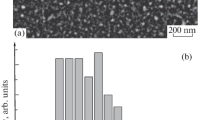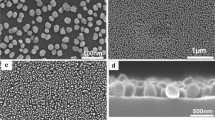Abstract
The mechanism of the vapor–solid–solid growth of Au-catalyzed GaAs nanowires in the temperature range of 420–450°C is investigated. For the first time, the effect of elastic stresses caused by a difference in the atomic densities of the catalyst and nanowire material on the solid-phase nucleation rate is considered. By assuming that the growth of the GaAs nucleus at the catalyst–nanowire interface is limited by the As-diffusion flux in the catalyst, it is shown that vapor–solid–solid growth can be implemented through the polycentric-nucleation mode in the temperature range under consideration. The intensity of the nucleation of coherent islands upon vapor–solid–solid growth is shown to be higher than the intensity of nucleation in the case of vapor–liquid–solid growth because a low interphase surface energy is implemented at coherent solid–solid conjugation. It is proved that the nucleation of Au-catalyzed GaAs nanowires by the vapor–solid–solid mechanism is possible only when GaAs-island growth proceeds due to As diffusion along the catalyst–nanowire interface.




Similar content being viewed by others
REFERENCES
S. Deshpande, J. Heo, A. Das, and P. Bhattacharya, Nat. Commun. 4, 1675 (2013).
M. A. Seyedi, M. Yao, J. O’Brien, S. Y. Wang, and P. D. Dapkus, Appl. Phys. Lett. 105, 041105 (2014).
M. P. van Kouwen, M. H. M. van Weert, M. E. Reimer, N. Akopian, U. Perinetti, R. E. Algra, E. P. A. Bakkers, L. P. Kouwenhoven, and V. Zwiller, Appl. Phys. Lett. 97, 113108 (2010).
J. Svensson, N. Anttu, N. Vainorius, B. M. Borg, and L. E. Wemersson, Nano Lett. 13, 1380 (2013).
A. Gao, N. Lu, P. Dai, C. Fan, Y. Wang, and T. Li, Nanoscale 6, 13036 (2014).
J. C. Harmand, G. Patriarche, N. Pere-Laperne, M. N. Merat-Gombes, L. Travers, and F. Glas, Appl. Phys. Lett. 87, 203101 (2005).
J. V. Wittemann, W. Münchgesang, S. Senz, and V. Schmidt, J. Appl. Phys. 107, 096105 (2010).
C.-Y. Wen, M. C. Reuter, J. Tersoff, E. A. Stach, and F. M. Ross, Nano Lett. 10, 514 (2010).
R. S. Wagner and W. C. Ellis, Appl. Phys. Lett. 4, 89 (1964).
B. J. Ohlsson, M. T. Bjork, A. I. Persson, C. Thelander, L. R. Wallenberg, M. H. Magnusson, K. Depperta, and L. Samuelson, Phys. E (Amsterdam, Neth.) 13, 1126 (2002).
A. I. Persson, M. W. Larsson, S. Stenstrom, B. J. Ohlsson, L. Samuelson, and L. R. Wallenberg, Nat. Mater. 3, 677 (2004).
K. A. Dick, K. Deppert, T. Martensson, B. Mandl, L. Samuelson, and W. Seifert, Nano Lett. 5, 761 (2005).
M. Tchernycheva, L. Travers, G. Patriarche, F. Glas, J. C. Harmand, G. E. Cirlin, and V. G. Dubrovskii, J. Appl. Phys. 102, 094313 (2007).
P. Krogstrup, J. Yamasaki, C. B. Sorensen, E. Johnson, J. B. Wagner, R. Pennington, M. Aagesen, N. Tanaka, and J. Nygard, Nano Lett. 9, 3689 (2009).
L. H. G. Tizei, T. Chiaramonte, D. Ugarte, and M. A. Cotta, Nanotechnology 20, 275604 (2009).
M. Tchernycheva, J. C. Harmand, G. Patriarche, L. Travers, and G. E. Cirlin, Nanotechnology 17, 4025 (2006).
F. Glas, J. Appl. Phys. 108, 73506 (2010).
K. A. Dick, J. Bolinsson, B. M. Borg, and J. Johansson, Nano Lett. 12, 3200 (2012).
V. G. Dubrovskii, G. E. Cirlin, and V. M. Ustinov, Semiconductors 43, 1539 (2009).
H. L. Duan, J. Wang, and B. L. Karihaloo, Adv. Appl. Mech. 42, 1 (2009).
D. Kashchiev, Cryst. Growth Des. 6, 1154 (2006).
S. A. Kukushkin and A. V. Osipov, Phys. Usp. 41, 983 (1998).
Y. Cai, S. K. Chan, I. K. Sou, Y. F. Chan, D. S. Su, and N. Wang, Adv. Mater. 18, 109 (2006).
V. G. Dubrovskii and N. V. Sibirev, Phys. Rev. E 70, 031604 (2004).
F. Glas, M. R. Ramdani, G. Patriarche, and J. C. Harmand, Phys. Rev. B 88, 195304 (2013).
Ya. B. Zel’dovich, Zh. Eksp. Teor. Fiz. 12, 525 (1942).
I. L. Aleiner and R. A. Suris, Sov. Tech. Phys. Lett. 16, 547 (1990).
A. R. Avery, H. T. Dobbs, D. M. Holmes, B. A. Joyce, and D. D. Vvedensky, Phys. Rev. Lett. 79, 3938 (1997).
J. W. Christian, The Theory of Transformations in Metals and Alloys (Pergamon, Amsterdam, 2002).
A. G. Khachaturyan, Theory of Structural Transformations in Solids (Dover, New York, 2008).
J. D. Eshelby, Proc. R. Soc. A 241, 376 (1957).
F. R. N. Nabarro, Proc. Phys. Soc. 52, 90 (1940).
E. Kroner, Acta Metal. 2, 301 (1954).
S. A. Kukushkin and A. V. Osipov, J. Phys. D: Appl. Phys. 47, 313001 (2014).
S. A. Kukushkin and A. V. Osipov, Key Eng. Mater. 528, 145 (2013).
S. Y. Karpov, MRS Internet J. Nitride Semicond. Res. 3, 16 (1998).
C. R. Chen, S. X. Li, and Q. Zhang, Mater. Sci. Eng. A 272, 398 (1999).
R. P. Elliott and F. A. Shunk, Bull. Alloy Phase Diagr. 2, 356 (1981).
Y. A. Burenkov, Y. M. Burdukov, S. Y. Davidov, and S. P. Nikandrov, Sov. Phys. Solid State 15, 1175 (1973).
L. R. Testardi, Phys. Rev. B 1, 4851 (1970).
J. C. Harmand, M. Tchernycheva, G. Patriarche, L. Travers, F. Glas, and G. Cirlin, J. Cryst. Growth 301, 853 (2007).
V. N. Kats, V. P. Kochereshko, A. V. Platonov, T. V. Chizhova, G. E. Cirlin, A. D. Bouravleuv, Yu. B. Samsonenko, I. P. Soshnikov, E. V. Ubyivovk, J. Bleuse, and H. Mariette, Semicond. Sci. Technol. 27, 015009 (2012).
N. L. Shwartz, M. A. Vasilenko, A. G. Nastovjak, and I. G. Neizvestny, Comput. Mater. Sci. 141, 91 (2018).
M. Ramdani, J. Harmand, F. Glas, G. Patriarche, and L. Travers, Cryst. Growth Des. 13, 91 (2013).
S. A. Kukushkin, Thin Solid Films 239, 16 (1994).
S. A. Kukushkin and V. V. Slezov, Dispersed Systems on the Surface of Solids (Evolutionary Approach): Mechanisms for the Formation of Thin Films (Nauka, St. Petersburg, 1996) [in Russian].
D. B. Butrymowicz, J. R. Manning, and M. E. Read, J. Phys. Chem. Ref. Data 6, 1 (1977).
S. Sakong, Y. A. Du, and P. Kratzer, Phys. Rev. B 88, 155309 (2013).
V. A. Gorokhov, T. T. Dedegkaev, Y. L. Ilyin, V. A. Moshnikov, A. S. Petrov, Y. M. Sosov, and D. A. Yaskov, Cryst. Res. Technol. 19, 1465 (1984).
J. Johansson and M. Ghasemi, Cryst. Growth Des. 17, 1630 (2017).
I. Ansara, C. Chatillon, H. L. Lukas, T. Nishizawa, H. Ohtani, K. Ishida, M. Hillert, B. Sundman, B. B. Argent, A. Watson, T. G. Chart, and T. Anderson, CALPHAD 18, 177 (1994).
J. Grecenkov, V. G. Dubrovskii, M. Ghasemi, and J. Johansson, Cryst. Growth Des. 16, 4526 (2016).
N. E. Newnham, Properties of Materials Anisotropy, Symmetry, Structure (Oxford Univ. Press, New York, 2005).
ACKNOWLEDGMENTS
A.A. Koryakin thanks the Russian Foundation for Basic Research, project no. 18-32-00559 for financial support of this study.
Author information
Authors and Affiliations
Corresponding author
Additional information
Translated by V. Bukhanov
Appendices
APPENDIX I
The chemical-potential difference Δμ can be estimated in the framework of the regular-solution model: Δμ = kTln(aAsaGa/K eq), where aAs and aGa are the arsenic and gallium activities in the catalyst, K eq is the constant of equilibrium of the chemical reaction of nucleus formation in the case of solid-phase nucleation. The constant K eq is determined from the equality of the chemical potentials of the particles in the catalyst and the island according to the following formula:
Here, \(\mu _{{{\text{As}}}}^{0}\), \(\mu _{{{\text{Ga}}}}^{0}\), and \(\mu _{{{\text{GaAs}}}}^{0}\) are the chemical potentials of pure arsenic, gallium, and GaAs (per atom) in the solid phase. The values of the chemical potentials are known functions of temperature [51].
Due to the difficulty of correct determination of the coefficients of interactions between particles in the solid phase, all estimates in this study were performed with aAs ≈ CAs and aGa ≈ CGa. We assume that taking into account the interaction coefficients in a solid does not affect the principal conclusions of this study. For example, if you use the interaction coefficients in the calculations found for the liquid phase [52], it leads to a correction to the chemical potential difference of ~50 meV at the arsenic and gallium concentrations under consideration, whereas its absolute value is ~300–500 meV.
To find the equilibrium pressure dependence of the arsenic-molecule pressure \({{p}_{{{\text{A}}{{{\text{s}}}_{2}}}}}\) on the concentration of arsenic dissolved in a catalyst particle, it is necessary to equalize the chemical potentials of arsenic in the catalyst and in the gas phase [25]. Then the value of \({{p}_{{{\text{A}}{{{\text{s}}}_{2}}}}}\) can be estimated by the formula
where \(\mu _{{{\text{A}}{{{\text{s}}}_{2}}}}^{0}\) is the chemical potential of molecular arsenic in the gas phase. Using the formula of molecular-kinetic theory for the pressure above a surface with a flux, we find that the arsenic equilibrium flux of \(j_{{{\text{As}}}}^{{{\text{eq}}}}\) (m–2 s–1) may be presented in the form
where
mAs is the arsenic-atom mass.
APPENDIX II
The matrices of elastic constants of the island and catalyst materials determined in [39, 40] are written in the coordinate system in which the unit vectors \({\mathbf{e}}_{x}^{0}\), \({\mathbf{e}}_{y}^{0}\), and \({\mathbf{e}}_{z}^{0}\) are collinear with respect to the crystallographic directions [100], [010], and [001]. For convenience of calculation of the elastic energy using the FEM, it is necessary to write the matrix of the elastic constants in a rotated coordinate system in which the Oz axis is directed along the crystallographic direction [111], i.e., to pass, for example, to basis ex = \(1{\text{/}}\sqrt 2 {\mathbf{e}}_{x}^{0} - 1{\text{/}}\sqrt 2 {\mathbf{e}}_{y}^{0}\), ey = \(1{\text{/}}\sqrt 6 {\mathbf{e}}_{x}^{0} + 1{\text{/}}\sqrt 6 {\mathbf{e}}_{y}^{0} - \sqrt {2{\text{/}}3} {\mathbf{e}}_{z}^{0}\), and ez = \(1{\text{/}}\sqrt 3 {\mathbf{e}}_{x}^{0} + 1{\text{/}}\sqrt 3 {\mathbf{e}}_{y}^{0} + 1{\text{/}}\sqrt 3 {\mathbf{e}}_{z}^{0}\). The matrix of elastic constants in GaAs in the rotated coordinate system is found from the formula C = MC0MT, where C, C0, are the matrix of elastic constants in the rotated and initial coordinate systems, and M is the transition matrix [53]. At the coordinate-system rotation under consideration, the transition matrix has the form
Then for the matrix of elastic constants of GaAs, we find (at T = 420°C)
The matrix of elastic constants for the catalyst material was found under the assumption that the crystallographic directions [100] and [010] of the catalyst coincide with the directions [100] and [010] of GaAs, respectively. The coincidence of the orientation of gold–gallium crystals formed on a GaAs(111) substrate and that of the substrate was found in samples obtained in [23]. Thus, using the transition matrix (A.II.1), we find the following values for the components of the elasticity matrix of the catalyst:
Rights and permissions
About this article
Cite this article
Koryakin, A.A., Kukushkin, S.A. & Sibirev, N.V. On the Mechanism of the Vapor–Solid–Solid Growth of Au-Catalyzed GaAs Nanowires. Semiconductors 53, 350–360 (2019). https://doi.org/10.1134/S1063782619030102
Received:
Accepted:
Published:
Issue Date:
DOI: https://doi.org/10.1134/S1063782619030102




